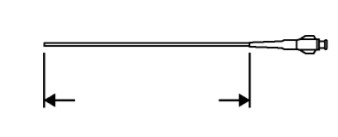Warnings
• This guide catheter and package are presterilized with ethylene oxide gas (EOG). Therefore, be sure not to open the package until just prior to use, and use the aseptic technique in handling this guide catheter. Do not resterilize this guide catheter. If resterilized, the performance or quality of this guide catheter may be compromised and there is a risk of complications including infection.
• This guide catheter is intended for a single use only. Do not reuse it. Reusing this guide catheter may damage it, and/or cause blood vessel damage.
• Check that this guide catheter and/or package is not damaged during transportation before use. Do not use if this guide catheter and/or package is suspected to be damaged.
• Do not use this guide catheter after the expiration date indicated on the label. Discard any guide catheter that exceeds the expiration date.
• This guide catheter must be used only by a physician who is fully trained in neuroradiology treatment.
• This guide catheter must be used in an institution where emergency surgical operation can be performed immediately.
• Do not modify this guide catheter for any reason. Never make new/additional side holes on this guide catheter shaft. (Using a modified guide catheter may damage this guide catheter and cause blood vessel damage. Making a side hole by any tool available in the hospital may cause blood clot formation in this guide catheter shaft and/or deteriorate this guide catheter performance of, or damage to this guide catheter shaft.)
• Do not use this guide catheter or the supplied dilator alone when inserting into a blood vessel. Doing so may damage this guide catheter, and cause to damage to the wall of the vessel by the tip of the supplied dilator or of this guide catheter (size or stiffness).
• Operate this guide catheter carefully, and if any resistance is felt, stop the manipulation and identify the cause of the resistance under X-ray fluoroscopy. Note that when using this guide catheter in combination with other devices, especially when the clearance between the lumen of this guide catheter and the combined device is small, the combined device may be stuck in this guide catheter. (Otherwise, this guide catheter may be damaged, causing the blood vessel to be damaged.)
• Do not insert the guide wire by force or advance it rapidly when this guide catheter is bent or twisted. (The guide wire may cause perforation or damage of this guide catheter, or result in blood vessel damage.)
• When applying torque manipulation to this guide catheter that is placed along the tortuous course of the vessel, take extra care and handle with caution because the manipulation may lead to kink or the like of this guide catheter, and may result in damage of the blood vessel or damage to this guide catheter.
• During procedures, use appropriate anticoagulant therapy by taking the patient's condition into consideration.
• Always refer to the insert and/or Instructions for Use attached to the medical devices to be used together with this guide catheter.
• Do not use ethiodol and/or lipiodol agents, or any agent containing these drugs. (These agents may cause the erosion of the connector resin and result in damage.)
• Do not use this guide catheter for a patient with blood coagulation disorder or severe change in coagulation ability due to any cause. Doing so may worsen the symptoms.
• Do not use this guide catheter for a patient who cannot adapt to surgical operations.
• Do not use this guide catheter for a patient who has had any severe and distinct reaction against the agents or the like necessary for the intended procedure. Doing so may cause side effects such as allergic symptoms or shock disease.
• Do not use this guide catheter for a patient who is or could be pregnant. (The fetus may be affected by X-rays under fluoroscopy.)
• Do not use this guide catheter for a patient who has had undue peripheral vascular disease which inhibits the insertion of a sheath introducer in the appropriate size.
• Do not use this guide catheter for a patient who is judged unsuitable for the procedure by the physician.
Precautions
• Prior to use, confirm that all devices including this guide catheter function normally.
• Check that the specifications of this guide catheter are suitable for the purpose of use and procedures.
• In case this guide catheter is inserted over an angiographic guide wire with hydrophilic polymer coating, advance this guide catheter gently, paying careful attention not to abrade the hydrophilic coating of the guide wire by the tip of the supplied dilator.
• Before use, make sure that this guide catheter is appropriate in size and shape, and compatible with other medical devices to be used in combination. Because the supplied dilator is dedicated to this guide catheter, do not use it with other Asahi Intecc guide catheters of different Fr sizes or other manufacturers’ guide catheters.
• Since the maximum guide wire diameter is as follows, use this guide catheter in combination with a guide wire having a diameter at or below the maximum guide wire diameter.
